NVIDIA Shield Review: At the Crossroads of PC and Mobile Gaming
by Brian Klug on July 31, 2013 12:14 AM ESTGFXBench 2.7.0
While GFXBench 2.7 (formerly GLBenchmark 2.7) doesn't yet take advantage of OpenGL ES 3.0 (GLB 3.0 will deliver that), it does significantly update the tests to recalibrate performance given the advances in modern hardware. Version 2.7 ditches classic, keeps Egypt HD and adds a new test, T-Rex HD, featuring a dinosaur in pursuit of a girl on a dirt bike.
Scene complexity goes up tremendously with the T-Rex HD benchmark. GLBenchmark has historically been more computationally bound than limited by memory bandwidth. The transition to T-Rex HD as the new flagship test continues the trend. While we see scaling in average geometry complexity, depth complexity and average memory bandwidth requirements, it's really in the shader instruction count that we see the biggest increase in complexity.

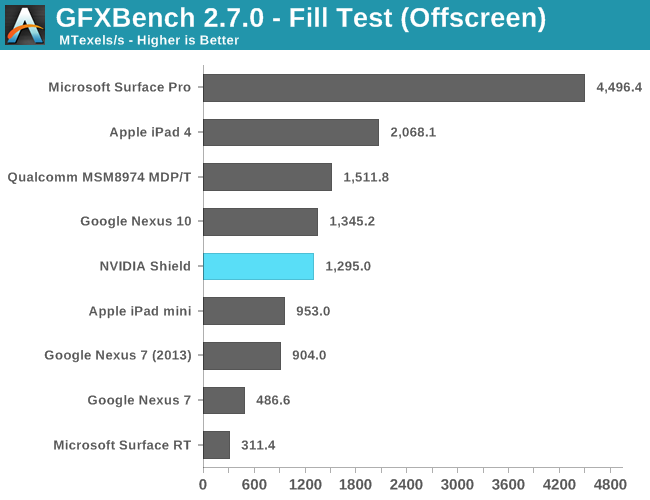
The fill rate tests put Shield significantly behind the iPad 4 and about on par with the Nexus 10. Looking at Triangle throughput we see Apple hold onto an advantage there as well, although Tegra 4 does show impressive gains over Tegra 3.
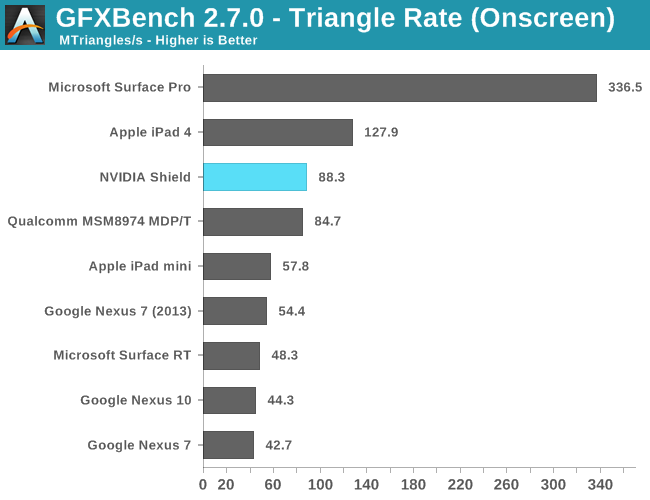
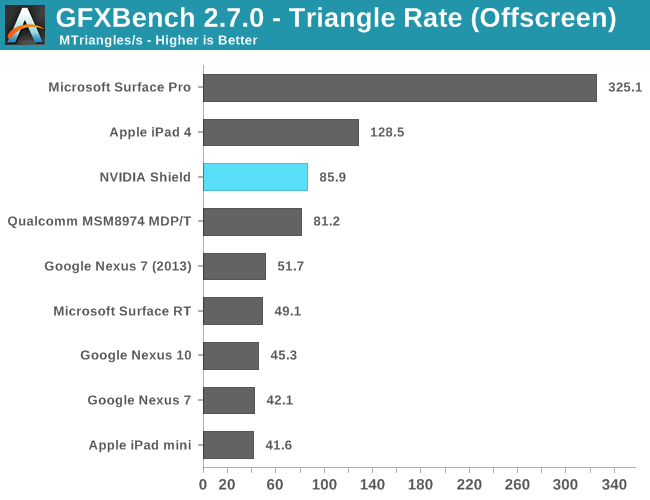
It's really in the pixel shader bound tests that Tegra 4 really excels:
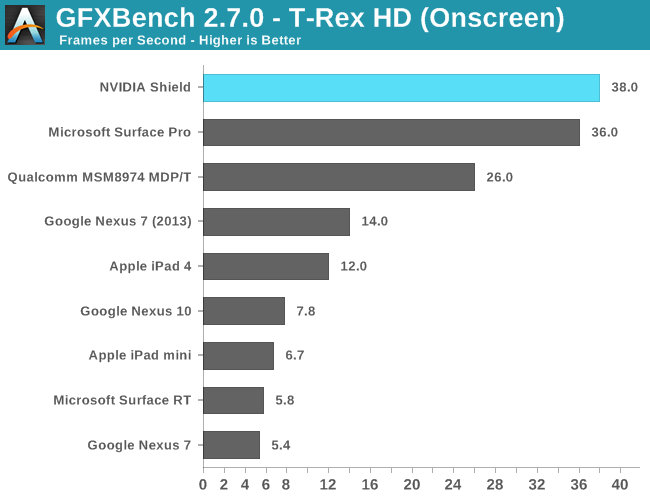
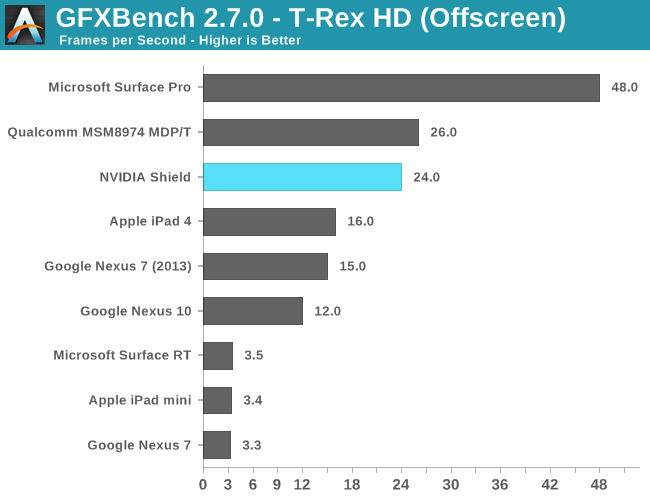
As promised, Tegra 4's GPU manages to outperform the iPad 4's PowerVR SGX 554MP4 in GFXBench 2.7. The 50% performance advantage is appreciable, and should be very nice on a high res display. It's a shame Shield is stuck with a 720p panel. Note that we're also half way to the performance of Intel's HD 4000 here. The Adreno 330 comparison is, once again, extremely close. Qualcomm pulls ahead by 8% and that's without a fan in a tablet chassis.
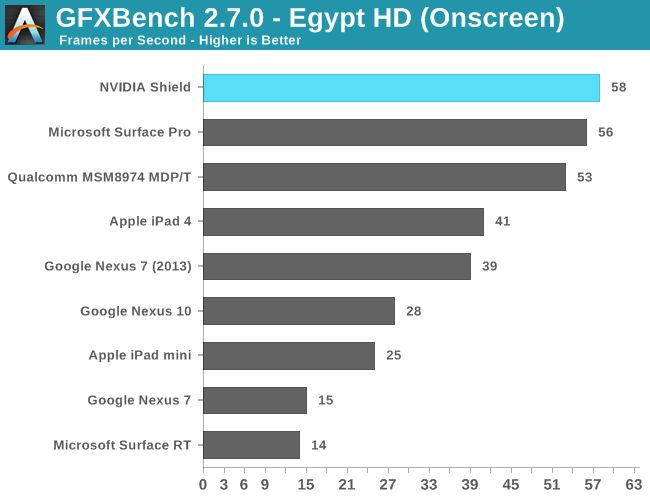
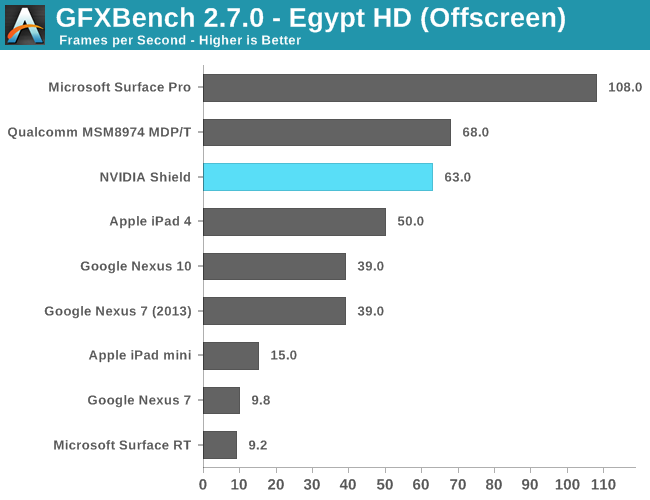










134 Comments
View All Comments
blanarahul - Wednesday, July 31, 2013 - link
Get the new Nexus 7. It has a larger screen so on screen controls won't be too bad. OpenGL ES 3.0 support is a big plus too.kmmatney - Wednesday, July 31, 2013 - link
On screen controls suck even on the much larger iPad. Emulators support RF controllers like the Wii Controller, but not enough official games do.varad - Wednesday, July 31, 2013 - link
Gamestop will probably have both devices on display. So you should be able to play with both and decide which one you like better!psuedonymous - Wednesday, July 31, 2013 - link
Much as I love the idea of the local streaming feature, you might be better served at this point with a Nexus 7, a DualShock 3 and a Gameklip.JeffFlanagan - Wednesday, July 31, 2013 - link
Thanks for mentioning the Gameklip. I hadn't heard of it, and just ordered one with cases for my Nexus 7 and Galaxy Note, in case the Nexus 7 is too top heavy to game comfortably.Subzero0000 - Thursday, August 1, 2013 - link
You should get Nexus 7. 'cus you can read online comfortably, and play some games occasionally. Buy a Android compatible controller if you must.Reading on the Shield is not going to be nice with the controller attached (unremovable) to it.
boozed - Wednesday, July 31, 2013 - link
Probably should rephrase the beginning of that second para to "It’s no secret that Tegra isn’t exactly the success that NVIDIA probably hoped it would be."Krysto - Wednesday, July 31, 2013 - link
Brian. The delay of Tegra 4 most likely not the main reason why Google didn't go with them this time. There are other more important reasons, such as"1) no LTE for Tegra 4, and Google wanted LTE for Nexus 7, one that works on all carriers
2) no OpenGL ES 3.0 support - was one of the main features of Android 4.3
3) S4 Pro is probably close to half the price of Tegra 4. If they wanted a more expensive chip, they could've gone with S600 at the very least
4) Power consumption might've played a role there, too. We need to see how Tegra 4 does in a tablet, although I honestly can't consider a chip a "mobile chip" if it can't be put in a smartphone because of too high power consumption.
SydneyBlue120d - Wednesday, July 31, 2013 - link
Well, let's take a look at the comments about Toshiba Excite Pro, the first sipping Tablet with Tegra 4 onboard, Toshiba Excite Pro http://amzn.com/B00D78Q2NQ :- I would have most definitely kept the tablet, had it not overheated. I realize that some overheating will hsppen under normal use. However, I was quite concerned when the unit overheated a lot after only 20 or 30 minutes of use.
- Runs extremely hot. After 10-15 mins playing light games or watching Netflix, its crazy hot
- It's overheat when play any game for 10mins
Ok, we don't know if it is Toshiba fault, however the fact that event on the shield it is running a fan, should sound quite dangerous...
Spunjji - Wednesday, July 31, 2013 - link
My thoughts exactly. I can't for a second believe that the chip can hold up its performance levels in a thermally constrained without something giving; something either being the ability to run cool or the performance itself.